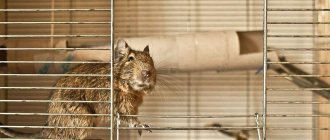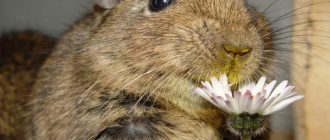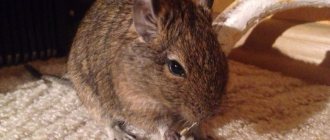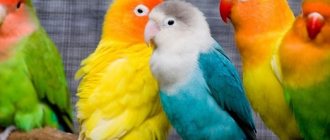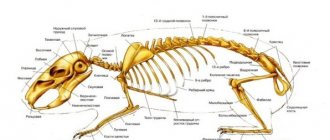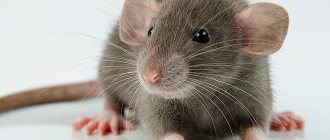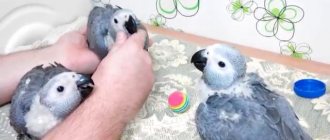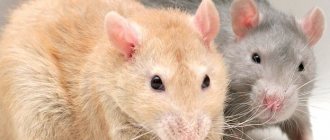Degus are quite unusual animals; their behavior is unlike any other. Thanks to their activity and friendliness, they have earned the love of many breeders. If you decide to purchase a degu, be sure to decide on the gender, because boys and girls have some differences. And so that you are not deceived when purchasing, it is important to learn how to correctly determine the sex of a degu.
Reproduction of squirrels
Squirrels generally have 1-2 litters; in the southern regions there are also 3. The interval between litters is approximately 13 weeks. The breeding season depends on climatic conditions, food availability, and population size. It usually starts in late January or early March and lasts until July-August. At this time, 3-6 males stay near the female. They behave aggressively towards each other, purr loudly, hit branches with their paws, and run after each other. The female chooses one of them, after which she builds a nest for the brood.
Top 10 Interesting Facts About Proteins
Squirrels are amazing animals. They can jump up to ten times their body length. They can rotate their hind legs 180 degrees, pointing them in any direction when they climb a tree. They have good eyesight and can learn by copying other animals, even humans. They are also active during the day, making them one of the few wild mammals that many of us get to see. Whether you consider them pests or a charming addition to our cities, there are plenty of reasons to find them fascinating. 10. Squirrel spies
Many of us have heard that animals are used in war, so when Iran found 14 squirrels with spy gear near the border, soldiers did the right thing and arrested them. The incident was reported by the country's official news agency and confirmed by the country's police chief, although he did not provide any details. Some Iranians were quite willing to believe that foreign powers could be training bushy-tailed agents. One of them even suggested that Great Britain was behind this operation. In any case, there are no further reports of squirrel infiltration, so the Iranians have had to go back to arresting pigeons. 9. Bubonic plague
You probably know that the bubonic plague is spread by rats, or rather fleas that live on them. Rats are generally associated with the disease, but fleas infected with the plague may well live on other rodents. One of the rodents that causes the greatest concern in the modern world is the squirrel. Between 2000 and 2009, 56 cases of plague were reported in the United States, and squirrels were among the main carriers. One notable case in 2012 was that of seven-year-old Sierra Jane Downing. She placed her sweater next to a dead squirrel while relaxing and became ill a few days later. Although the bubonic plague has killed tens of millions of people throughout history, it is treatable with antibiotics, and Sierra made a full recovery. In 2013, authorities closed a camp in the Los Angeles National Forest after an infested squirrel was found there. That same year, a 15-year-old boy from Kyrgyzstan died after catching the disease from a mountain squirrel, and 100 people had to be quarantined. 8. Obstacle courses
You may have heard that the Internet is like a network of pipes, but that's not entirely true. In reality, it's more like a series of rabbit holes that you wander down until you notice that the sun has set, you're hungry, and you have dozens of browser tabs open. If you love cute little animals, look up “squirrel obstacle courses” on YouTube. You'll get a ton of results that will keep you busy all day looking at them. Squirrels are smart and can learn to overcome numerous obstacles to find the most efficient route to food. In fact, one of the hardest parts of creating an obstacle course for these little rodents is that they are very good at discovering where shortcuts can be taken. However, if they complete the course according to plan, they are more than capable of jumping onto rickety platforms, spinning windmills, and running along tight ropes. They can even roll around in small baskets. 7. Squirrels and rattlesnakes
Photo: jkirkhart35 California squirrels have spent the last 10 million years in an arms race with rattlesnakes, and they've come up with some clever ways to ward off predators. They have fantastic reflexes and can react quickly enough to dodge a snake in the split second it takes for the reptile to lunge. Snakes must be sure that they attack their potential meal with the maximum element of surprise or it is not worth the energy to charge. Rattlesnakes sense their prey using thermal radiation. If squirrels notice the snakes first, or enter an area where there may be an ambush, they raise their tails and direct a rush of blood there. This causes the tail to become warm and stands out as a beacon for snakes. Even though this may literally sound like the worst possible maneuver, snakes recognize this gesture as "I know you're there, so you won't surprise me" and therefore don't even try to attack. The same squirrels also came up with a way to ward off predators that track prey by scent. They find a dead rattlesnake, chew its skin, and then lick themselves. This makes the squirrels smell like snakes, and scientists say it tricks the animals into thinking that the squirrel's burrows are actually the habitat of a nearly meter-tall flexible and poisonous danger rather than a tasty mammal snack. 6. Saber-toothed squirrel
One of the most legendary fictional squirrels isn't actually a squirrel at all. Scrat, the acorn-loving creature from the Ice Age, is actually a completely fictional species. His image, no matter how charmingly awkward it was, did not impress experts. Paleontologist Guillermo Rougier of the University of Louisville said, "When Ice Age came out, we thought the squirrel character in it looked ridiculous." However, in 2002, the same year the film was released, a team of paleontologists unearthed a number of fossils in Argentina. One of their finds was a 60-million-year-old mammal skull that looked exactly like a squirrel skull with an elongated snout and saber teeth. Although the new find may have looked like Scrat, she most likely did not share his love of acorns. Scientists think it likely used its huge fangs to hunt insects, but they aren't sure. The species, named Cronopio dentiacutus, is unlike any animal living in the world today, except in the world of animation. 5. Winter supplies
The most famous behavior of squirrels is storing nuts and acorns for the winter. This habit is necessary for many species of squirrels that do not hibernate. Researchers at the University of California have discovered that squirrels have a desire to hoard a wide range of food items, including acorns, walnuts, hazelnuts, and a bunch of other foods. When a small animal buries a seed in the ground, it is good for the tree from which it fell. Squirrels are considered extremely important to forest growth and are partly responsible for the spread of oak trees across much of the Americas. Hoarding nuts comes with its own risks, and one species of squirrel has developed a backup plan. If they run out of food, they collect maple syrup directly from the trees. The squirrel cuts the maple bark with its teeth, allowing the sap to flow out, and later returns to lick it when it dries. Although this strategy has only been observed by science in this century, the traditional story of the Iroquois people suggests that maple syrup was first discovered when a young boy saw a squirrel licking a tree. 4. Particularly annoying pests
Small mammals are notorious pests, and each species has its own specific way of causing problems. Rats will eat basically anything, rabbits breed like rabbits, and the squirrel's talent for causing trouble lies in its ability to perform acrobatics. The very thing that makes obstacle course videos so entertaining is what makes it difficult to keep squirrels off property. That's why the first result that comes up in an image search for "squirrel-proof bird feeder" is a photo of a squirrel happily eating from a squirrel-proof bird feeder. While you may not be able to hope to keep squirrels out of your garden, there are some places that might do a little better. For example, active silos of US nuclear launchers. But no, the people in charge of an arsenal that could literally destroy civilization had to resort to trial and error to stop the invasion of Richardson's gophers. Malmstrom Air Force Base in Montana houses 150 nuclear missiles, each capable of firing three warheads more powerful than the bomb dropped on Nagasaki. Among the measures designed to protect the missiles are motion sensors that are triggered if anything violates the perimeter around the bunkers. However, gophers are not only capable of climbing over fences, they are also excellent diggers. The length of tunnels dug by Richardson's gophers can exceed 9 meters. Thousands of false security alerts have been caused by their habit of appearing in restricted areas. They also caused damage to roads, power lines, and building foundations. The first attempt to keep gophers from digging tunnels was a combination of iron mesh and steel fabric installed underground. The gophers chewed their way through this fortification (wrong because living next to nuclear weapons turned them into Hulk gophers). Many fence materials were tried, but the gophers simply climbed over it. The Air Force has finally found a combination that seems to work - a solid plastic fence above ground, and solid sheet metal underground. The gophers stopped entering the base area. At least for now.
3. Nutty Narrows Bridge
Photo: Avi In 1963, Longview, Washington, had a problem. Squirrels have died trying to cross a busy highway. A kind local resident offered to build the bridge for free, and the local council named it Nutty Narrows. An 18-meter bridge was installed over the road, and, in fact, turned the city into the squirrel-loving capital of America. The city now hosts an annual Squirrel Festival. There is also a web camera installed on the bridge that broadcasts online in real time. When the bridge was removed to be cleaned, local residents held a ceremony to mark its return. Three more bridges have been installed and several more are likely to be installed in the future. The president of the local Rotary Club said: “We will make this city dark with so many bridges.” Spartan enthusiasm of this kind destroyed empires, so let's hope that everything will be fine with the squirrels. 2. Squirrel masturbation
Male Cape ground squirrels have truly enormous genitalia, relatively speaking. The length of their penis is 40 percent of their body length, while the length of their scrotum is half the length of the penis. A long penis provides an unimaginable advantage during masturbation, and their technique achieved what many believe to be the ultimate goal: squirrels bend over and put the penis in their own mouth. Researcher Jane Waterman followed animals in Namibia to see if there was any benefit to this behavior, or if it was simply an unintended consequence of a high sex drive. She found that males were more likely to masturbate after mating than when they were unable to find a female. Waterman believes that masturbation can help cleanse the genitals both externally and internally, reducing the risk of infection. She believes this behavior may be similar to the fact that some men feel the urge to urinate after orgasm, but because squirrels live in the desert, they use a method that allows them to retain water in their bodies. 1. Squirrel Mysteries For the past few years, squirrels have been at the center of mysteries. In one case, they were found to be behind a spate of soap thefts on the streets in England. Residents were left baffled by the disappearance of their toiletries until a squirrel was spotted running out of a bathroom window with a bar of soap. No one is sure exactly what the squirrels did with their prey because they usually hid quickly. When someone on Reddit posted a photo of what looked like a black demon monkey crawling along a fence, the community spent some time trying to figure out what dimension the creature came from. The photo at the center of the mystery was taken from behind, but when a photo of the creature's face was found, it became quite obvious that it was a hairless squirrel. In 2012, another photo of a strange-looking squirrel caused a stir on the Internet. It was quite obviously a squirrel, but it was clearly purple. The animal was captured by a Pennsylvania family who took several photographs of the animal in a cage. It is not clear how the animal began to look like a plum; perhaps the squirrel ate something, or rolled around in something that was painted.
Regardless of the reason for this coloration, this is not the first time this has happened. A purple squirrel became a local celebrity at a school in the south of England in 2008. Maybe she stole the wrong type of soap?
The common squirrel (veksha) is a small fur-bearing animal from the squirrel family. This is one of the most active and graceful rodents in the forest. The animal's fur is valuable to hunters. Also, some gourmets use squirrel meat for food. When hunting squirrels, no special skill or talent is required, but luck, luck and endurance will not be superfluous.
Getting offspring
Adults are considered to be degus that have reached one year of age. However, squirrels that are only 50 days old can begin the mating process. For this to happen, the animals must be on good terms with each other. If the owner wants his pet to produce offspring, he needs to take care of a suitable pair in advance. You need to purchase an individual of the opposite sex and place it with the animal that already lives at home.
You should carefully observe the behavior of the couple, because it is possible that the female and male may not get along with each other. In this case, one of them may show aggression towards their partner.
If the animals do not fight and treat each other favorably, offspring can be expected. It is recommended to remove objects from the cage that could injure the pregnant squirrel or the babies she gives birth to. These include shelves with food and a wheel.
Individuals close in blood are not suitable for mating, since the squirrels may be born weak and sick. The most suitable partners are those who are six months old. After birth, the male is placed in a separate cage. This is done to prevent re-mating. The female is ready to bear a fetus and give birth no more than once a year.
How to distinguish a boy from a girl degu?
The degu is a small South American rodent weighing 100-500 grams and 9-22 cm in length.
Suitable for both breeding and regular home keeping. The animal will be a good friend for the child, it will teach him to bear responsibility for a living being and be responsible for his actions. Before you buy a degu, you need to decide on the sex of the animal. Boys are more friendly, get used to their owner faster and almost immediately become tame, live more calmly alone, are better trained, and girls, having a slightly more capricious character, and, in addition, can naturally give birth to offspring if there is a male degu.
But since in nature they still live in groups, it is advisable to keep them in same-sex pairs if breeding is not part of the plans. If it does, then all the same, it is necessary to separate them by gender and place them next to each other only for the mating period and to help in caring for the newborn offspring.
This is necessary because the instinct of reproduction is not alien to rodents, although the young become sexually mature at 6-8 months; mating is possible earlier, but this is extremely undesirable. Such a litter is born weak and non-viable.
Visually determining the sex of a rodent is not easy. All degus are the same size, color and their genitals are not visible. Under the tail there is an anus and a cone-shaped process, which is present in both females and males. Out of ignorance, some people perceive it as a penis, but this is not so. The genitals, like the testicles in males, are located in the abdominal cavity, and can only be seen during mating, and the urethra is located in the appendage.
Description and habits of the squirrel
These are rodents with a nimble body, a fluffy tail and elongated erect ears. These animals need a long tail not only for beauty: it is a kind of “rudder” that helps when flying from tree to tree. Squirrels also use their tails to cover themselves during sleep. The average length of individuals is 20-30 cm, but there are also giants (up to 50 cm) and small animals (6 cm)
Coat color – red, dark brown, gray. The color depends on the time of year: in winter, squirrels are gray, their fur is dense; in summer, their fur is red, short, and sparse. Squirrels can live in any forest plantings: from squares and parks to impassable coniferous thickets. Individuals feed during the day and wait out the nights in hollows.
Brief information about the life of squirrels:
- reproduction occurs in autumn and spring;
- duration of pregnancy – 35 days;
- one litter can have from 3 to 8 animals;
- squirrels have sharp claws and strong teeth that help in gnawing food;
- diet – varied vegetation (parts of trees, seeds, berries, mushrooms);
- character traits of squirrels - suspiciousness, slight aggressiveness, cunning;
- individuals can swim, but do not like dampness;
- when danger appears, the squirrel stands on its hind legs, freezes and looks out for the enemy, while it can make loud, drawn-out sounds, warning its comrades;
- The lifespan of forest wild squirrels is no more than 4 years.
These animals are active, they are in constant motion. They move along the ground by jumping: they rest on their front legs, and their hind legs move forward. They climb trees with a screw. They jump over the distance between trees; such jumps can reach 1 m in length.
Can individuals of different sexes live together?
It is not advisable to keep individuals of different sexes together . Degus reach puberty at a fairly early age, but they are not yet ready to give birth during this period. Early pregnancy will lead to a delay in the development of the female, and the offspring will be weak, sick, and the babies may be stillborn.
For a quiet life of degus of different sexes, it is better to keep them in different enclosures. Moreover, under natural conditions, males and females live separately.
Sources:
https://kotopes.ru/kak-opredelit-pol-degu https://www.rostki.info/index.php/belki/616-degu-kak-opredelit-pol.html https://jivotina.com/ degu/kak-opredelit-pol-degu/
Squirrel habitat
Squirrels cannot be confidently called territorial animals. Based on this feature, two types of squirrels are distinguished: resident and migratory. Sedentary squirrels occupy a certain habitat, be it parks, squares, certain areas of the area, and even city landfills. They live in this area constantly, feed, build nests and raise offspring. Migratory squirrels are in constant migration, moving from one territory to another. Often such migration is caused by forest fires. They can be easily distinguished from sedentary ones by the worn fur on the inside of their paws.
Squirrel weight is 200–400 grams. The length is approximately 30 centimeters, and the squirrel’s tail is equal to the length of the body. The color shades of squirrels depend on their habitat, but generally in summer the squirrel is fiery red, in autumn and spring it is reddish-gray, and in winter it changes its red-gray fur to a fluffy gray coat. It is with the onset of cold weather and the change of fur that the hunt for squirrels begins.
Of course, squirrel fur cannot be compared with the fur of marten, beaver or sable, from which large items (fur coats, hats, coats) are made. But nevertheless, it is quite valuable and is usually used to trim linings or collars. Unlike mink, squirrels in Russia are not raised in captivity for fur, and the influx of their skins to the market comes from hunters - both amateurs and commercial hunters.
External differences of rodents
Externally, male and female degus are very similar. By their nature, females are noticeably larger. It all depends on genes. Males and females have the same coat color and the same hair density. The reproductive organs are located in the peritoneum and become visible closer to the age of maturation. The girl has a hole from which the heat is released. It occurs in female degus at the age of 4 months.
The male gains weight during the breeding season. His abdomen enlarges and his testes become closer to his scrotum. The cloaca and urethra are covered by the tail. In the first case, the organ is located closer to the tail, and the channel is hidden under it.
It is easy to tell a degu boy from a girl. In boys, the distance between the organs is 1 centimeter. It is recommended to view animals when they are sitting peacefully in the palm of your hand. Under no circumstances should you pick up a degu in your hand and turn it over.
External differences of degus
The animal will perceive the action as aggression. This is the only way to determine the sex of a squirrel. Thus, the young animals are distributed immediately. Children can be separated from their mother at the age of one and a half months.
Until this time, the puppies eat milk and after two weeks they go through the process of adaptation to external food. The male is placed with the offspring and begins to raise the babies.
Hunting tricks
The first condition for a successful hunt is preliminary reconnaissance and choice of location. It is advisable to devote the first day entirely to searching for places where squirrels feed and fatten. After discovering these routes, you need to monitor the behavior of the individuals.
Reference. To find out for sure whether there are squirrels in the forest, you can simply let the dogs off the leash. Forest animals will instantly start jumping onto the trees.
The key to successful reconnaissance is a suitable hunter's suit and the presence of binoculars. You will need a camouflage suit that will allow you to get lost between the trees. Squirrels are very attentive and cautious; when they see a person, they immediately leave on horseback or climb into their hollows.
For shooting, it is advisable to use a small-caliber carbine equipped with optics. Such weapons have a number of advantages over conventional guns:
- low noise level;
- there is no need to reload after each shot.
The optimal distance for a shot is 10 m. The hunter must wait until the squirrel freezes, then pull the trigger. If the squirrel is active and does not intend to stop, you can whistle quietly - the animal will stand alert on its hind legs and freeze.
So, squirrel hunting is a labor-intensive process that requires patience. These are mobile animals that are highly sensitive: the animals have acute hearing and instantly hide when they detect enemies. Therefore, when hunting squirrels, it is important to be careful and completely silent.
The common squirrel, or veksha, is the name by which the squirrel was known in Rus'. Its habitat is huge and occupies almost the entire territory of Russia. This is primarily due to its unpretentiousness to its environment and the wide range of foods it consumes as food. It eats almost everything: nuts, roots, berries, plant seeds, mushrooms, and also does not hesitate to destroy the nests of small birds, which is, in principle, characteristic of any rodent.
How does seating occur?
A lonely squirrel begins to mark the territory and everything that is located on it. Since she lives alone, the squirrel will try to protect her home from strangers. At the age of ten months, rodents are physiologically prepared for reproduction.
It is forbidden to immediately move a male to a female. As a result of a sudden acquaintance, both animals can experience severe stress. The female will perceive her relative as an enemy and may attack.
If the male is a leader by nature, he may react negatively to the behavior of his new “acquaintance.” He will immediately begin to defend his position and rush into battle. Often, fights escalate into brutal battles, resulting in severe injuries to degus. To prevent such an ending, the owners gradually introduce the animals to each other:
- First, the cells of both individuals are placed next to each other. The squirrels gradually get used to each other and begin to communicate.
- filler from the opposite cage is poured into the sand baths of each rodent. This is how proteins distinguish each other's smells.
- The first walks together should not last more than an hour.
- after a few weeks the animals begin to play together.
The sex of a newborn baby degu can be determined immediately. Animals are under observation within a month and a half from the moment of birth, since it is during this period that they are separated from their mother. Separating the females from the males will help prevent the female from having an unwanted early pregnancy. In any case, it is important to avoid inbreeding when breeding.
Degus are quite unusual animals; their behavior is unlike any other. Thanks to their activity and friendliness, they have earned the love of many breeders. If you decide to purchase a degu, be sure to decide on the gender, because boys and girls have some differences. And so that you are not deceived when purchasing, it is important to learn how to correctly determine the sex of a degu.
Female or male? How to determine the sex of a squirrel
Since the genital organs of rodents (including squirrels) of different sexes are very similar, gender is not determined by the shape of the genital organs or the presence of testes. The testes of male squirrels are still in the abdominal cavity and are not visible, but in mature males the testes descend into the scrotum outside the abdominal cavity and become visible only during the rutting period (they begin to be visible at the end of autumn, reach their full dimensions during the rutting period, and by the middle summers disappear). So the most reliable way to determine the sex of a squirrel is the distance between the genitals (pink “button”) and the anus. The female's genitals (the pink “button”) are very close to the anus - literally a couple of millimeters.
In a sexually mature female, during the period of estrus, the genitals (pink “button”) swell.
In the male, the genitals (pink “button”) are located at a distance from the anus - closer to the stomach.
A sexually mature male during the rutting period - the scrotum with testes is clearly visible.
Important points
When determining the sex of your degu, pay attention to the following points:
Do not pick up the degu from above - it may get scared. Always handle the rodent from the side so it can see your hand.
Do not turn your degu over or put him on his back - he will not like this and may become aggressive.
Do not pull the degu's tail upward with force - you will only need to slightly lift the tail to see the distance from the anus to the canal.
As you can see, the most important thing in all these manipulations is not to scare your pet and to be as careful as possible, because any rough and sudden movement can discourage the degu from getting to know you for a long time.
How to correctly determine the sex of a Chilean squirrel
Remember that degus do not like careless movements, so when determining sex, handle the animal with extreme caution. If during this period it receives severe stress, it may get sick and even die.
When inspecting, follow the rules:
- do not take the animal from above, it may identify it as danger and bite;
- touch the animal gently;
- do not pull the tail, as this may cause him to throw off the fur from the tail and gnaw off the exposed appendage;
- do not squeeze the animal’s body.
In general, treat it very carefully. It is better to entrust the manipulation to the breeder, because the pet is already accustomed to it and is not afraid. You, in turn, can only conduct an inspection.
By appearance
You will not be able to determine the gender based on this feature. Individuals have the same color and do not have characteristic external features. Size and weight also vary depending on genetic data, living conditions, care, nutrition and other factors.
Important! It is impossible to determine the sex of a degu by appearance.
What sexual characteristics do individuals have?
The degu's genitals are located in the abdominal cavity and are not visible upon examination. They are visible only during female estrus and mating. Therefore, it will not be possible to distinguish individuals by their genitals.
On a note! Some people mistake the degu's cone-shaped appendage for the male's genital organ, but both sexes have this appendage .
The only way to distinguish a boy from a girl is to examine the abdomen. In its lower part there is a cone-shaped process and the urethra. In males and females they are located at different distances from each other. In the female, the process and the canaliculus are located very close, in males there is a distance between them the size of the width of a thumb.
Determining the sex of adult degus
Boys and girls degus are very similar in appearance, so just by looking at a rodent, it will be difficult for you to determine what gender it is. To determine the sex of a degu you should:
carefully place the degu on a flat surface, distracting it with a treat;
lift the tail and look carefully at the area where the anus is located.
You will see the anus (the circle of skin closer to the tail) and a cone-shaped appendage. Pay attention to this appendage: it is present in both females and males and is not a penis, as one might initially assume. This process contains the urethra, and the genitals themselves in degu boys are hidden inside the abdominal cavity . In female degus, the genitals are also firmly closed and not visible : they can only be noticed during the mating period. So how can you determine the sex of a degu if it “hides” its genitals? The sex of these rodents is determined only by the distance between the anus and the appendix with the urethra . In males this is the distance of the little finger, but in females it is practically absent.
Treats for degus
A favorite delicacy is dandelion. Its advantage is that it can be given in large quantities and in any form. Degus can be fed fresh dandelion leaves, stems and flowers. Give leaves and roots in dried form; stems and flowers do not dry well.
As a treat, you can sometimes feed the animal a piece of fresh bread or a cracker. However, bread can be offered extremely rarely and in small quantities.
We invite you to read: Sarcoptic mange in cats: treatment, symptoms, medications. Sarcoptic mange in cats: signs, symptoms and treatment methods What is sarcoptic mange in cats
Squirrel hunting methods
There are several hunting methods available, each of which deserves consideration.
Hunting with a husky
This is the main method of hunting. Success depends on the dog's performance characteristics:
- acute sense of smell;
- excellent hearing;
- good vision;
- preliminary training (at least 6 months).
Laika must first find and then track the found squirrel. Experienced hunting dogs stand away from the animal's feeding area and raise their voices. At the same time, the hunter should not come close to the dog, since the squirrel may go into the thicket at the sight of a person. Novice huskies immediately rush to the tree, whine and break branches, while the squirrel leaves on horseback.
Hunting by tracking
Tracking is a method that involves detecting an animal in the direction of its movement (following its tracks). A squirrel can also be detected by shallow but quite noticeable scratches that remain on the bark after the animal’s claws. At the same time, you need to remember that squirrels do not run away from their shelters further than 20-30 m. The appropriate time for hunting is early morning.
Algorithm for hunting by tracking a squirrel:
- After finding a tree where the squirrel is feeding, you need to go around it. There should be no traces to the side or traces of weeds.
- Next, the hunter must freeze and look out for prey.
- If the squirrel is not detected visually, you need to hide and continue observing - the animal will definitely give itself away.
- You need to shoot when the animal has finished eating and climbed along the crown to look for new food.
On a note! Squirrel tracks will be clearly visible in fresh snow. Also, as the animal moves, you can find fragments of bark, dead needles, seeds, and broken branches.
Hunting with an air gun
| Hunting conditions and action | Description |
| Hunting time | Dawn |
| Habitat | The tree where the squirrel feeds can be found by characteristic sounds: a noisy falling of a cone, a clattering sound; as if they were gnawing on something hard. |
| Where should the hunter be? | The optimal distance is 30 m to the place where the individual is fed. In this case, you need to hide behind the trunks. |
| Rifle requirements | Caliber – 4.5-5.5 mm, energy – 5-40 or 7-65 J, bullet weight – 0.88 g, shot range – 50-60 or 100-120 m. |
Hunting with traps
In dense coniferous forests, hunting with dogs or using pneumatic guns is impossible. The way out of the situation is wood traps.
The nuances of hunting in this way:
- Preliminary preparation. Clean the traps from grease and boil in “fir” water. The wood is additionally rubbed with pine needles.
- The trap should have the shape of a triangle.
- Install at a distance of 40-100 cm from the ground.
- Installation location – tall cedars, trunk diameter – 20-30 cm.
- The distance between traps is 50-150 steps.
- Suitable baits are mushrooms and cedar cones. Lay out in a cascade: the first bait at a height of 1 m, the second below - 40-60 cm from the ground.
Installed traps should be inspected every 3-4 days. If delayed, the carcasses of captured squirrels may be damaged by mice or predatory animals. One trap can catch up to 30 individuals.
Squirrel hunting with husky
Squirrel hunting with a dog is perhaps the most exciting of other types of squirrel hunting, and the number of animals hunted far exceeds other methods of hunting. It has its own specificity and its most important component is, first of all, the dog. Not every breed is suitable for this purpose. Russian hunters prefer to hunt squirrels with huskies, since these dogs genetically have a “saddle” or “top” sense. The squirrel is a rather nimble animal and, escaping from pursuit, it rushes at high speed along the treetops, jumping from the top of one tree to another, in leaps several meters long. With such a speed of pursuit, a dog is needed that can “keep” the squirrel in sight for a long time. The dog should not be too quick and, having discovered the animal, should not bark at it profusely, since the animal, frightened, will run away through the upper crowns of the trees, making it difficult for the hunter to make an accurate shot. Ideally, the dog should warn the owner with several “barks” and, making a stand, keep the squirrel in sight until the person approaches. To achieve this level, a dog needs constant training, and best of all, practice. However, such hunting is short-lived and, as a rule, it stops with the appearance of deep snow covers.
Squirrel hunting with bare hands
Squirrel hunting “stealth”, or simply speaking on foot, is probably the most common, since it does not require any additional equipment. All you need is a little attention, a good rifle and knowledge of the habits of squirrels. The squirrel moves along the ground in large leaps, up to half a meter long, so that it is not difficult for an attentive person to see a feeding squirrel. In case of danger, the squirrel does not hide in the bushes, but, as a rule, with a loud “clop”, warns the entire area about the threat. All that remains is to carefully approach the animal and fire an accurate shot. In case of severe fright, she can hide in the crown of trees and will not leave her shelter, even if she persistently knocks on the tree trunk.
It should be remembered that the Veksha is “strong to wound” and, being seriously wounded, can continue to hide from pursuit. In this case, it is most reasonable to continue the pursuit, waiting until the squirrel is exhausted and “getting” the animal, rather than taking an extra shot, thereby ruining the animal’s skin. You should not grab a wounded squirrel with your hands, as this seemingly cute animal can cause serious injury if it bites.
In any case, squirrel hunting is a very exciting activity for both amateurs and professional hunters.
How to distinguish a female degu squirrel from a male

